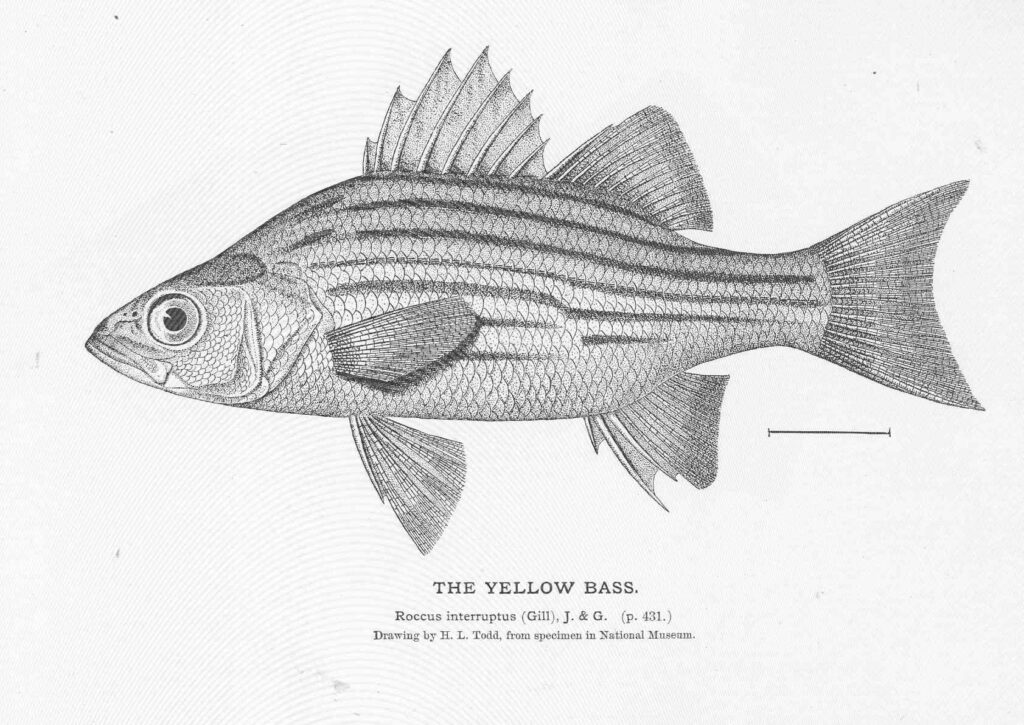Yellow Bass
Morone mississippiensis
Largest yellow bass ever recorded weighed 2.95 pounds
Advertisement
Yellow Bass Scientific Classification
- Kingdom
- Animalia
- Phylum
- Chordata
- Class
- Actinopterygii
- Order
- Perciformes
- Family
- Moronidae
- Genus
- Morone
- Scientific Name
- Morone mississippiensis
Read our Complete Guide to Classification of Animals.
Yellow Bass Conservation Status
Yellow Bass Facts
- Prey
- Copepods, aquatic insects, fish
- Main Prey
- Fish
- Name Of Young
- Fry
- Group Behavior
- School
- Fun Fact
- Largest yellow bass ever recorded weighed 2.95 pounds
- Estimated Population Size
- Hundreds of millions
- Biggest Threat
- Environmental changes
- Most Distinctive Feature
- Golden-yellow color
- Distinctive Feature
- Offset lateral lines above anal fin
- Gestation Period
- 4-6 days
- Temperament
- Aggressive
- Habitat
- Calm, slow-moving rivers, streams, and lakes
- Predators
- Northern pike, walleye, catfish
- Diet
- Carnivore
- Lifestyle
- Crepuscular
- Favorite Food
- Fish
- Number Of Species
- 1
- Location
- Mississippi River system and its tributaries
- Nesting Location
- Shallow tributaries
- Migratory
- 1
Yellow Bass Physical Characteristics
- Color
- Yellow
- Black
- Gold
- Silver
- Olive
View all of the Yellow Bass images!
Summary
Morone mississippiensis, or the yellow bass, belongs to the temperate bass family Moronidae. This small, aggressive fish originally hails from the Mississippi River and several of its nearby tributaries. Yellow bass congregate in large schools, which means determined anglers can easily catch many in a single fishing session. That said, most anglers tend not to prize yellow bass due to their small size.

The largest yellow bass on record weighed around 2.95 pounds.
©https://digitalmedia.fws.gov/ – License
5 Facts
- It gets its specific name (mississippiensis) from the Mississippi River.
- Juveniles school together to avoid predators and grow relatively quickly until they mature.
- The largest on record weighed around 2.95 pounds.
- In some areas, it is viewed as an invasive species due to its aggressive nature, predatory habits, and ability to reproduce and grow quickly.
- They can live up to 7 years in the wild.
Classification and Scientific Name
They belong to the order Perciformes, or “perch-like fish.” It is a member of the temperate bass family Moronidae, which includes freshwater and marine species. Currently, it shares the genus Morone with 3 other species. These include the white perch (Morone americana), white bass (Morone chrysops), and striped bass (Morone saxatilis). The origin of the genus name remains unknown to this day. However, the name persists, and no other suitable names exist to replace it. It derives its specific name, mississippiensis, from the Mississippi River. Its common name refers both to the characteristics it shares with other bass and to its bright golden-yellow color.
Appearance

The yellow bass is viewed as an invasive species due to its aggressive nature, predatory habits, and ability to reproduce and grow quickly.
©https://digitalcollections.lib.washington.edu/digital/collection/fishimages/search – License
The yellow bass ranks as the smallest member of the temperate bass family. On average, most adults measure between 5 and 11 inches long and just under 1 pound in weight. The majority weigh around 8 and 11 ounces but some specimens can weigh 2 or 3 times that size. The largest on record weighed in at 2.95 pounds and measured just over 16 inches long.
In terms of appearance, they closely resemble white bass and yellow perch. You can distinguish them from other species based on a few characteristics. Yellow bass feature 5 to 7 dark stripes along each side. Typically, the lines near the belly appear broken rather than solid and the stripes above the anal fin are offset. Additionally, unlike other members of its genus, the yellow bass lacks tooth patches on its tongue. The yellow bass sports between 9 and 10 anal rays.
They look predominantly golden-yellow. However, the belly appears lighter and the top appears darker than the sides. In most specimens, the belly looks silvery with a hint of yellow, while the back appears olive green.
Distribution, Population, and Habitat
Traditionally speaking, yellow bass originate from the Mississippi River. However, you can also find them in several of the Mississippi’s tributaries, including the Tennessee River and Trinity River. They range as far north as Minnesota and as far south as Louisiana. In recent years, the range has grown as they’ve been introduced to new waterways. Today, you can find them as far west as Arizona.
Yellow bass prefer quiet, slow-moving rivers, lakes, streams, and reservoirs. It enjoys relatively clear water but can tolerate some turbidity. They frequently congregate in areas that feature a solid substrate. The type of substrate doesn’t particularly matter so long as it is firm and can range from mud and sand to rock and gravel. During the summer months, yellow bass often move to deeper water to feed. At this time, you’ll most likely find them at depths ranging from 10 to 20 feet below the surface. Meanwhile, they often move into more shallow water during cooler months. In winter, you’ll frequently find yellow bass at depths of 6 to 12 feet. In lakes with lots of vegetation, they often congregate near the edges of any underwater cover.
Predators and Prey

Due to their small size, numerous animals prey on yellow bass. Common yellow bass predators include
bluegill
.
©RLS Photo/Shutterstock.com
Due to their small size, numerous animals prey on yellow bass. Common predators include bluegill, northern pike, walleye, catfish, and other bass. Additionally, they often consume their own young.
The diet of a yellow bass varies depending on its age and size. Juveniles mostly feed on small crustaceans (copepods) and aquatic insects. As they grow, their diet consists mostly of small fish. They often prey on minnows, shiners, and shad. In addition to fish, adults will also feed on small crustaceans. During early morning and evening yellow bass often feed near the surface of the water when light is low. They move to deeper water during the day, at which point they mostly act as benthic bottom-feeders. Yellow bass are notoriously aggressive predators and will move together in large schools when they detect food.
Reproduction and Lifespan
The spawning season usually takes place during spring. At this time, yellow bass normally migrate to shallow tributaries to spawn, but some populations in lakes may spawn over gravel bars or rocky reefs. Either way, spawning normally takes place in shallow water between 2 and 3 feet deep. Females lay on their sides to expose their eggs, which the males then fertilize from above when they release their sperm into the water. The eggs measure only 0.031 inches in diameter and, once fertilized, will sink. The yellow bass fry hatch after 4 to 6 days. Unlike black bass, they do not guard or care for their young. In fact, adults will often prey on their own fry as soon as they hatch.
Yellow bass grow quite quickly as juveniles. However, their rate of growth slows once they reach sexual maturity at around 2-3 years old. They don’t live that long, as the average yellow bass doesn’t live past seven years old.
Food and Cooking
Despite their small size, many people enjoy cooking and eating yellow bass. They are relatively easy to clean and possess a mild, somewhat sweet flavor. In terms of taste, some people compare the yellow bass to walleye or crappie. The meat is quite flaky and firm and lends well to frying or baking.
Population
At present, no studies exist that accurately describe the overall population. However, some local surveys have attempted to count their numbers in certain areas. For example, in some parts of Iowa the yellow bass is classified as an invasive species. The population in the state has exploded in a relatively short amount of time. One survey conducted in 2004 at Lake Icaria in Iowa estimated that around 784,000 yellow bass lived in the lake. In comparison, at the time the lake supported a largemouth bass population of just under 400 and a walleye population under 700. Given its fast growth rate and widespread distribution the total population likely numbers in the hundreds of millions. Currently, the IUCN lists them as a species of Least Concern.
View all 32 animals that start with YYellow Bass FAQs (Frequently Asked Questions)
Are yellow bass carnivores, herbivores, or omnivores?
Yellow bass are carnivores that prey on other aquatic animals. As juveniles they mostly eat aquatic insects and copepods. Meanwhile, adult yellow bass mainly prey on small fish. Small crustaceans make up the remainder of their diet.
How large can yellow bass get?
Yellow bass don’t grow as large as other members of the temperate bass family. On average, most yellow bass will weigh just under a pound and measure between 5 and 11 inches long. However, they can grow up to just under 3 pounds and over 16 inches at maximum size.
Are yellow bass solitary?
Yellow bass congregate in large schools both as juveniles and as adults. They rely on the strength of numbers to help protect themselves from predators and also to find food.
How do you catch yellow bass?
You can catch yellow bass with a wide range of lures, including jigs, spoons, and spinners. Many anglers choose to use minnows and other live bait to catch yellow bass. During the day, you should try to present your lure near the bottom of the lake or river where yellow bass congregate.
Thank you for reading! Have some feedback for us? Contact the AZ Animals editorial team.
Sources
- , Available here: https://www.iowadnr.gov/Fishing/Iowa-Fish-Species/Fish-Details/SpeciesCode/YLB
- , Available here: https://www.iowadnr.gov/idnr/Fishing/Fishing-Tips-How-Tos/How-to-Fish-For-/Yellow-Bass
- , Available here: https://tpwd.texas.gov/huntwild/wild/species/yellowbass/
- , Available here: http://www.fishin.com/forums2/content.php/764-New-World-Record-Yellow-Bass-Caught-by-Indiana-Man-at-MorseLake
- , Available here: https://globegazette.com/dnr-battling-yellow-bass-problem-in-southern-iowa-lakes/article_95a9343f-9c78-5637-b357-92fa4eae2a81.html#:~:text=Sobotka%20has%20surveyed%20Icaria%20and%20estimates%20there%20are,Iowa%20lakes%2C%22%20Sobotka%20said.%20%22It%27s%20worse%20than%20domination.%22

















